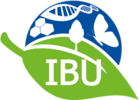Anna-Maria Hartmann
Anna-Maria Hartmann
Curriculum Vitae
| 2002 | University entrance diploma at the Johannes-Bugenhagen-Gymnasium in Franzburg |
| 2002 – 2007 | Biology studies at the University of Rostock |
| 2007 | Diploma thesis at the University of Rostock “Characterization of the 1,8 cineole synthase from Nicotiana suaveolens” (Prof. Dr. Birgit Piechulla, AG Biochemistry) |
| 2007 – 2010 | Dissertation at the Carl-von-Ossietzky University of Oldenburg “Analyses of the regulation and structure of the cation chloride cotransporter family” (Prof. Dr. Hans Gerd Nothwang, AG Neurogenetics) |
| since 2012 | Postdoc at the Carl-von-Ossietzky University of Oldenburg “Phylogenetical and functional analyses of the cation chloride cotransporter gene family” (Prof. Dr. Olaf R.P. Bininda-Emonds, AG Systematics and Evolutionary Biology & Prof. Dr. Hans Gerd Nothwang, AG Neurogenetics; funding, DFG) |
Research interests – Phylogenetic and functional analyses of the cation chloride cotransporter gene family
The cation chloride cotransporter (CCC) family comprises four subfamilies – K+-Cl- cotransporters (KCCs), Na+-K+-2Cl- cotransporters (NKCCs), and Na+-Cl- cotransporters (NCCs) – and possibly two additional members as well – cation chloride cotransporter interacting protein (CIP1) and polyamine transporters (CCC9s). Altogether, CCCs often play essential physiological roles in transepithelial ion reabsorption and secretion, cell volume regulation and inhibitory neurotransmission and are present across all domains of life.
Within the scope of my DFG funded postdoc ("Phylogenetical and functional analyses of the cation chloride cotransporter (CCC) gene family"), I will infer the phylogenetic history of the CCC family to clarify when the different subfamilies evolved as well as investigate which structural changes are necessary for their different functions. As a starting point, I performed a comprehensive phylogenetic analysis using publically available genomic information. The results clearly support CIP1 as being a true CCC based on shared evolutionary history. By contrast, the status of CCC9 in this regard remains equivocal. I also revealed the existence of a single, putatively ancestral CCC gene, a direct descendent of which is still present in Archaea. From this gene, numerous duplication events at the base of archaeans and eukaryotes led to the divergence and subsequent neofunctionalization of the paralogous CCC subfamilies that we see today. A diversity of ensuing gene-loss events resulted in the complex distribution of CCCs present across the different taxa. Importantly, the occurrence of KCCs in “basal” metazoan taxa like sponges would enable the early formation of fast hyperpolarizing neurotransmission in metazoans.
In my future work, I will focus on the characterization of the ancient CCC members to investigate their basal function.
Publications
Hartmann, A.-M., Nothwang, H. G. (2015) Molecular and evolutionary insights into the structural organization of cation chloride cotransporters. Frontiers in Neuroscience 8: 470.
Weber, M., Hartmann, A.-M., Beyer, T., Ripperger, A., Nothwang, H. G. (2014) A novel regulatory locus of phosphorylation in the C-terminus of the potassium chloride cotransporter KCC2 that interferes with N-ethylmaleimide or staurosporine mediated activation. Journal of Biological Chemistry 289(27):18668–79.
Hartmann, A.-M., Tesch, D., Nothwang, H. G., Bininda-Emonds, O. R. P. (2014) Evolution of the cation chloride cotransporter family: ancient origins, gene-losses, and subfunctionalization through duplication. Molecular Biology and Evolution 31: 434–447.
Rosengauer, E., Hartwich, H., Hartmann, A.-M., Rudnicki, A., Somisietty, S., Avraham, K., Nothwang, H. G. (2012) Egr2::Cre mediated conditional ablation of Dicer disrupts histogenesis of mammalian central auditory nuclei. PlosOne 7:e49503.
Döding, A., Hartmann, A.-M., Beyer, T., Nothwang, H. G. (2012) KCC2 transport activity requires the highly conserved L675 in the C-terminal of ß1 strand. Biochemical and Biophysical Research Communications 420: 492–497.
Hartmann, A.-M., Nothwang, H. G. (2011) Opposite temperature effect on transport activity of KCC2/KCC4 and N(K)CCs in HEK293 cells. BMC Research Notes 4: 526.
Hartmann, A.-M., Abarzua, S., Schlichting, A., Richter, D.-U., Leinweber, P., Briese, V. (2011) Effects of elm bark extracts from Ulmus laevis on human chorion carcinoma cell lines. Archives of Gynecology 284:1256–9.
Hartmann, A.-M., Wenz, M., Mercado, A., Störger, C., Mount, D.B., Friauf, E., Nothwang, H. G. (2010) Differences in the large extracellular loop between K+-Cl- cotransporters KCC2 and KCC4. Journal of Biochemistry 285: 23994–24002.
Hartmann, A.-M., Blaesse, P., Kranz, T., Wenz, M., Schindler, J., Kaila, K., Friauf, E., Nothwang, H. G. (2009) Opposite effect of membrane raft perturbation on transport activity of KCC2 and NKCC1. Journal of Neurochemistry 111: 321–31.
Wenz, M., Hartmann, A.-M., Friauf, E., Nothwang, H. G. (2009) CIP1 is an activator of the K+-Cl- cotransporter KCC2. Biochemical and Biophysical Research Communications 381: 388–92.
Roeder, S., Hartmann, A.-M., Effmert, U., Piechulla, B. (2007) Regulation of simultaneous synthesis of floral scent terpenoids by the 1,8-Cineole synthase of Nicotiana suaveolens. Plant Molecular Biology 65: 107–124.
Matscheski, A., Richter, D.-U., Hartmann, A.-M., Effmert, U., Jeschke, U., Kupka, M. S., Abarzua, S., Briese, V., Ruth, W., Kragl, U., Piechulla, B. (2005) Effects of phytoestrogen extracts isolated from rye, green and yellow pea seeds on hormone production and proliferation of trophoblast tumor cells Jeg 3. Hormone Research 65: 276–288.

